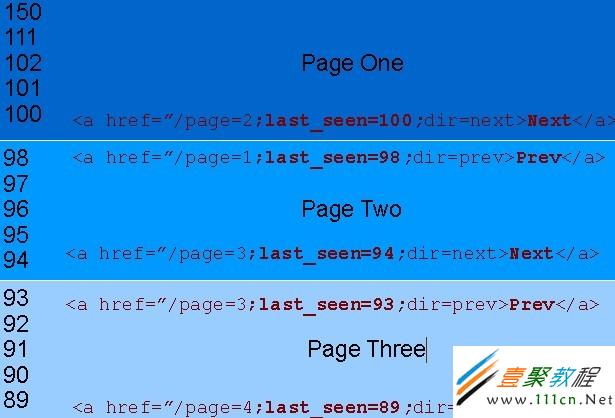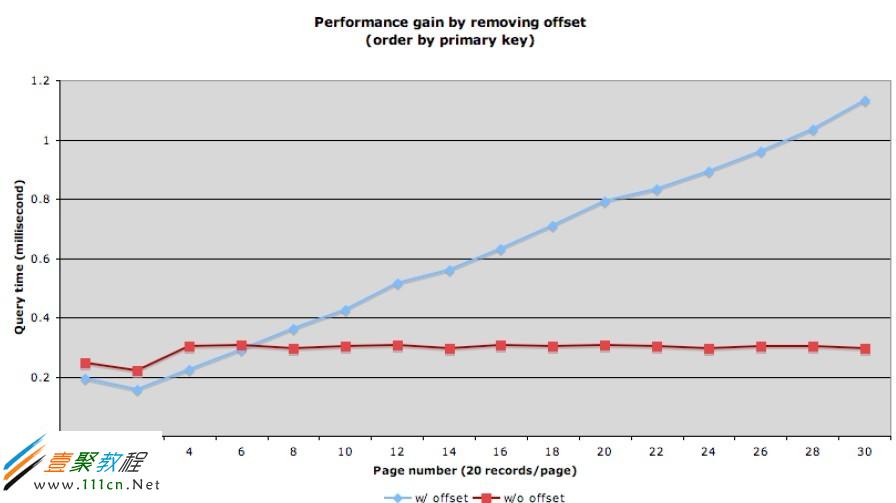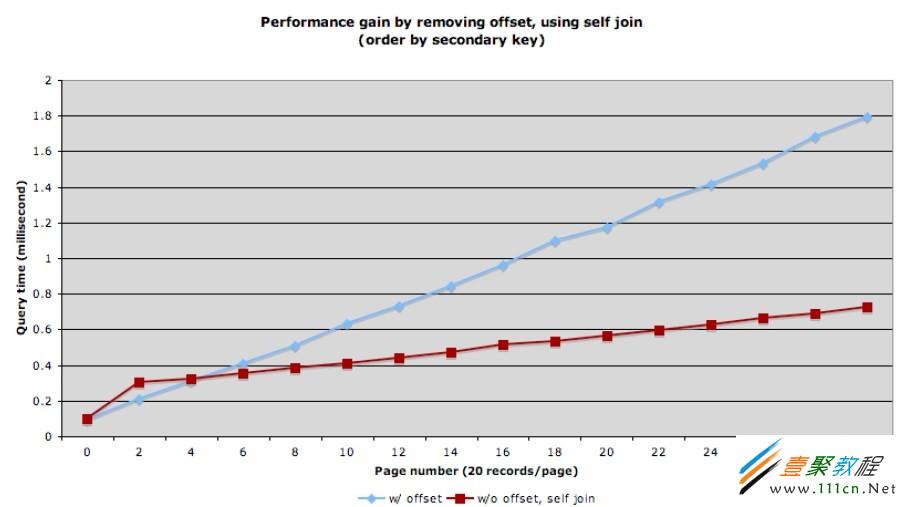萬盛學電腦網 >> 數據庫 >> mysql教程 >> MySQL高效分頁與分頁優化分析
MySQL高效分頁與分頁優化分析
- 常見分頁方式
- schema設計和常見的分頁方式(偏移)
- 避免分頁偏移過大的技巧
- 性能對比
- 重點

三.前提
大記錄表要高效分頁
- WHERE條件使用索引完成
- WHERE條件和排序能夠使用同個索引完成
- http://dev.mysql.com/doc/refman/5.1/en/mysql-indexes.html
- http://dev.mysql.com/doc/refman/5.1/en/order-by-optimization.html
- http://dev.mysql.com/doc/refman/5.1/en/limit-optimization.html
- ORDER BY a
- ORDER BY a,b
- ORDER BY a, b, c
- ORDER BY a DESC, b DESC, c DESC
- WHERE a = const ORDER BY b, c
- WHERE a = const AND b = const ORDER BY c
- WHERE a = const ORDER BY b, c
- WHERE a = const AND b > const ORDER BY b, c
- ORDER BY a ASC, b DESC, c DESC /* 混合ASC和DESC */
- WHERE g = const ORDER BY b, c /* 字段g不是索引一部分 */
- WHERE a = const ORDER BY c /* 沒有使用字段b */
- WHERE a = const ORDER BY a, d /* 字段d不是索引的一部分 */
代碼如下 復制代碼CREATE TABLE `message` ( `id` int(11) NOT NULL AUTO_INCREMENT, `title` varchar(255) COLLATE utf8_unicode_ci NOT NULL, `user_id` int(11) NOT NULL, `content` text COLLATE utf8_unicode_ci NOT NULL, `create_time` int(11) NOT NULL, `thumbs_up` int(11) NOT NULL DEFAULT '0', /* 投票數 */ PRIMARY KEY (`id`), KEY `thumbs_up_key` (`thumbs_up`,`id`) ) ENGINE=InnoDB mysql> show table status like 'message' G Engine: InnoDB Version: 10 Row_format: Compact Rows: 50000040 /* 5千萬 */ Avg_row_length: 565 Data_length: 28273803264 /* 26 GB */ Index_length: 789577728 /* 753 MB */ Data_free: 6291456 Create_time: 2009-04-20 13:30:45兩個分頁例子:
- 按照time(發布時間)分頁,新發布的在前面
- 按照thumps_up(投票數)分頁,票高的在前面
1.統計記錄數量
代碼如下 復制代碼SELECT count(*) FROM message2. 查詢當前頁
代碼如下 復制代碼SELECT * FROM message ORDER BY id DESC LIMIT 0, 20
- http://domain.com/message?page=1 ORDER BY id DESC LIMIT 0, 20
- http://domain.com/message?page=2 ORDER BY id DESC LIMIT 20, 20
- http://domain.com/message?page=3 ORDER BY id DESC LIMIT 40, 20
六、explain
代碼如下 復制代碼mysql> explain SELECT * FROM message ORDER BY id DESC LIMIT 10000, 20G ***************** 1. row ************** id: 1 select_type: SIMPLE table: message type: index possible_keys: NULL key: PRIMARY key_len: 4 ref: NULL rows: 10020 Extra: 1 row in set (0.00 sec)
- 它可以使用索引,並且只要找到需要的結果後就停止掃描.
- LIMIT 10000, 20 需要讀取前10000行,然後獲取後面的20行
- 較大的偏移(OFFSET)會增加結果集, MySQL has to bring data in memory that is never returned to caller.
- Performance issue is more visible when your have database that can’t fit in main memory.
- 小比例的低效分頁足夠產生磁盤I/O瓶頸
- 為了顯示“第 21條 至 40條 (共 1000000),需要統計1000000行
- 不顯示記錄總數,沒用戶在乎這個數字
- 不讓用戶訪問頁數比較大的記錄,重定向他們
- 不顯示總數,讓用戶通過“下一頁”來翻頁
- 緩存總數,顯示一個大概值,沒有用戶在乎是324533條還是324633 (譯:測試在乎-_-!!)
- Display 41 to 80 of Thousands
- 單獨統計總數,在插入和刪除時遞增/遞減
- 更改ui,不提供跳到某頁的按鈕
-
LIMIT N 是高效的, 但不要使用 LIMIT M,N
- 從WHERE條件裡找到分頁(LIMIT N)的線索
- Find the desired records using more restricted WHERE using given clue and ORDER BY and LIMIT N without OFFSET)

譯:last_seen是id。這裡的分頁只有“上一頁”、“下一頁” 按鈕
十一、根據線索解決方案
下一頁: http://domain.com/forum?page=2&last_seen=100&dir=next
WHERE id< 100 /* last_seen */ ORDER BY id DESC LIMIT $page_size /* 沒有偏移 */上一頁:
- http://domain.com/forum?page=1&last_seen=98&dir=prev
WHERE id > 98 /* last_seen */ ORDER BY id ASC LIMIT $page_size /* 沒有偏移 */譯:通過每頁第一條或最後一條記錄的id來做條件篩選,再配合降序和升序獲得上/下一頁的結果集
十二、根據線索解決方案
代碼如下 復制代碼代碼如下 復制代碼 99mysql> explain SELECT * FROM message WHERE id < '49999961' ORDER BY id DESC LIMIT 20 G *************************** 1. row *************************** id: 1 select_type: SIMPLE table: message type: range possible_keys: PRIMARY key: PRIMARY key_len: 4 ref: NULL Rows: 25000020 /* 忽略這裡 */ Extra: Using where 1 row in set (0.00 sec)十三、當你排序的字段不是唯一的,怎麼辦?
99
98 第一頁
98
98 98
98
97 第二頁
97
10 我們不能這樣查詢:
代碼如下 復制代碼WHERE thumbs_up< 98 ORDER BY thumbs_up DESC /* 結果將返回重復的記錄 */我們可以這樣查詢:
代碼如下 復制代碼WHERE thumbs_up <= 98 AND <額外的條件> ORDER BY thumbs_up DESC十四、額外的條件
- 考慮到 thumbs_up 是“主要字段”,如果我們添加一個“次要字段”,我們可以使用“主要字段”和“次要字段”作為查詢條件
- 其次,我們可以考慮使用id(primary key)作為我們的次要字段
第一頁:
代碼如下 復制代碼SELECT thumbs_up, id FROM message ORDER BY thumbs_up DESC, id DESC LIMIT $page_size +-----------+----+ | thumbs_up | id | +-----------+----+ | 99 | 14 | | 99 | 2 | | 98 | 18 | | 98 | 15 | | 98 | 13 | +-----------+----+下一頁:
代碼如下 復制代碼SELECT thumbs_up, id FROM message WHERE thumbs_up <= 98 AND (id < 13 OR thumbs_up< 98) ORDER BY thumbs_up DESC, id DESC LIMIT $page_size +-----------+----+ | thumbs_up | id | +-----------+----+ | 98 | 10 | | 98 | 6 | | 97 | 17 |十六、優化
查詢:
代碼如下 復制代碼SELECT * FROM message WHERE thumbs_up <= 98 AND (id < 13 OR thumbs_up < 98) ORDER BY thumbs_up DESC, id DESC LIMIT 20我們可以這樣寫:
代碼如下 復制代碼SELECT m2.* FROM message m1, message m2 WHERE m1.id = m2.id AND m1.thumbs_up <= 98 AND (m1.id <13 OR m1.thumbs_up< 98) ORDER BY m1.thumbs_up DESC, m1.id DESC LIMIT 20;十七、explain
代碼如下 復制代碼*************************** 1. row *************************** id: 1 select_type: SIMPLE table: m1 type: range possible_keys: PRIMARY,thumbs_up_key key: thumbs_up_key /* (thumbs_up,id) */ key_len: 4 ref: NULL Rows: 25000020 /* 忽略這裡 */ Extra: Using where; Using index /* Cover 譯:Cover就是說所需要的數據之從索引裡獲取就可以滿足了 */ *************************** 2. row *************************** id: 1 select_type: SIMPLE table: m2 type: eq_ref possible_keys: PRIMARY key: PRIMARY key_len: 4 ref: forum.m1.id rows: 1 Extra:十八、性能提升


十九、吞吐量提升
每頁30條記錄,查看第一頁的話,使用 LIMIT OFFSET, N方式,可以達到 600 次查詢/秒,如果使用 LIMIT N (無偏移)方式,提升到 3.7k 次查詢/秒
二十、Bonus Point
Product issue with LIMIT M, N User is reading a page, in the mean time some records may be added to
previous page. Due to insert/delete pages records are going to move forward/backward
as rolling window:
– User is reading messages on 4th page
– While he was reading, one new message posted (it would be there on page
one), all pages are going to move one message to next page.
– User Clicks on Page 5
– One message from page got pushed forward on page 5, user has to read it
again No such issue with news approach
二十一、不足
SEO專家會說:Let bot reach all you pages with fewer number of deep dive 兩個解決方案:
Two Solutions:
• Read extra rows
– Read extra rows in advance and construct links for few previous & next pages
• Use small offset
– Do not read extra rows in advance, just add links for few past & next pages
with required offset & last_seen_id on current page
– Do query using new approach with small offset to display desired page
mysql教程排行
程序編程推薦
相關文章
copyright © 萬盛學電腦網 all rights reserved



